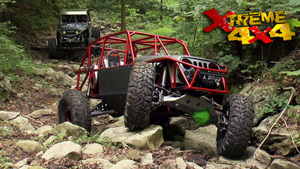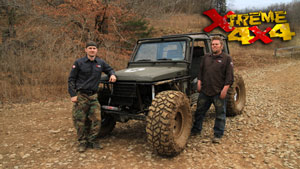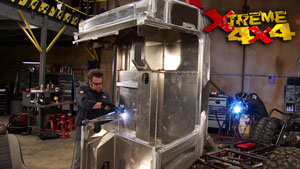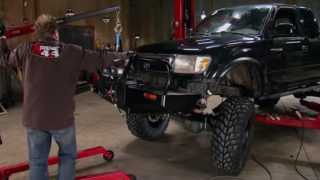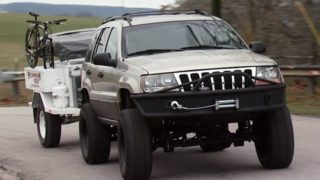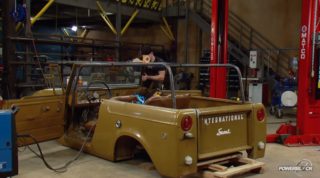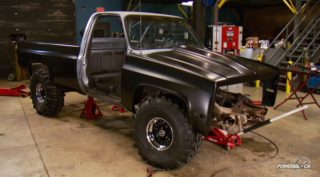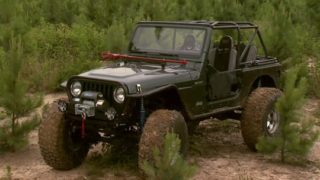More '85 Suzuki Samurai Episodes
Xtreme 4x4 Builds
Want more content like this?
Join the PowerNation Email NewsletterParts Used In This Episode
Pro Comp
Deep buttress lug and dynamic tread design, plus extended sidewall tread enhance soft surface traction and provide additional bite in rock crawling applications.
Pro Comp
Jeep suspension systems
Red Rock 4-Wheelers Club
The Red Rock 4-Wheelers, Inc. is a non-profit club organized to bring together adventure loving individuals and families who share the common interest of active four-wheeling in the Moab area.
Trail Gear Inc.
A transfer case 6.5:1 low gear set with all the bearing and seals included. Plus differential armor, creeper gussets, and front knuckle rebuild kits.
Episode Transcript
Today. Part two of our Suzuki build as project Samurai goes from mild to wild. Plus before you buy tires and suspension parts, they got to pass the test here. We'll travel the Moab
rim trail with design engineers anxious to show off their latest Xtreme 4x4 starts now.
Hey guys, welcome to Xtreme 4x4. In part two of our
Suki Samurai build basically a small trail truck that is designed to go through the trails while the other trail trucks have to go over or can't even make it through.
Plus it's all done on a budget
so far we've got it all the drive.
There's two used rebuilt Toyota axles sitting underneath it on a four link with coils, front and rear. Also drop the transfer case out to get ready for a set of low ratio gears. Now, budget wise, how much have we spent so far? Including the tires is 2600 and we're gonna get out of here by the end of the day, less than a grand.
Oh,
yeah,
very springy.
Now, if you remember we pulled the transfer case out of our Suzuki last time in order to get it ready for a set of low ratio gears. Now, the nice thing about the gear ratios available for this small divorce transfer case is that the most popular one is a 6.5 to 1 low gear ratio. What that means is by installing
these gears into the transfer case, we don't have to change the axle gears in order to get a good crawl ratio for our 35 inch tall tires. Now, our kit comes from trail gear and not only does it include the gears and all the other shafts but also all the bearings and seals. So when we're done, the transfer case will be fully rebuilt and good to go
with the fluid drains. And the four wheel drive indicator and de
10 ball removed both front and rear yokes can be taken off,
then remove the lock tab on the counter shaft
and the case is ready to be split.
The input gear,
counter shaft gears
and output shaft gears are next
completely disassembled. The output gear assembly
then replace the low speed
and high speed gears
with the new pieces and trail gear,
then strip to input shaft of both bearings
and install them onto the new unit.
Put the counter shaft in to see where the case must be clearance
and grind where required
then reassemble the transfer case, reversing the order that it came apart in
using all new gaskets and seals
afterwards, it can be installed back into the truck.
We also got a bunch of stuff from trail gear, including the farmer creeper gussets and front knuckle rebuild kits. Because when you're servicing your Toyota axle, when you're doing a solid axle swap is great insurance when you're out on the trail.
One of the reasons that the Suzuki Samurai is so popular on the trails is because of its weight. They're really lightweight trail rigs
and also they just look really cool. Now on this one, we will be adding a complete exo
cage because we have to trim away. These body panels are
in the way of our larger tires.
And what some people do is basically back half these trucks and turn them into almost like a tube buggy. No, we don't want to do that because we still want to keep the style of the Suzuki itself. Now, the reason the cage is going on the outside,
honestly, there's just no room inside.
Now, I know what you guys are thinking
that looks like a pretty good truck to just start cutting into pieces. But trust me, if you take your time measure, cut in the right places, when all the tube gets put in, this thing will look just as good, if not better than when we rolled it in here in the first place.
Get it
right
now with the tires in place. You can really get an idea of what this truck is gonna look like as a finished project.
Now so far, including the transfer case gears. We're well under three grand with this thing and it's looking like a serious trail machine, but right now it needs some tube.
Now, sometimes when you're building an exo
cage like this,
the hardest part is honestly choosing where to start.
Now, the majority of this cage is going to be an inch and a half dom tubing.
And I've taken this 6 ft long piece and put a 45 degree angle at the front to carry up underneath the bar that will run into the hood. This will be our starting point
and then we'll take a similar piece with another 45 degree angle and just continue it on from the back. Keeping everything as close to the body as we can
to keep it nice and tight on the trail.
Welcome back to Xtreme 4x4. You know, we get emails all the time asking us where our favorite place to go is
in what
I would say, call
Ontario, mid February minus 20 snow. Wh
Wow. I would have to say more.
You talk with gorgeous views, endless amounts of rocks and the weather is always great
with well over 50 trails, there's no place on the planet quite like Moab
Utah.
They call Moab
the Mecca of off roading. There are so many trails. So there's something for everybody. What makes willing here unique is the Slick Rock. Slick Rock. Got its name by the cowboys that were here in those early days, steel hoops on the horses, you know, sliding around
chasing after those long eared cattle.
They didn't like it at all. They had to go chase cattle on Slick rock, the name stuck.
And nowadays so do the tires. It's not slick. This stuff is literally like 36 grid sandpaper. You can push the limits of your tires of your vehicle farther than any other place I've ever seen. You get to drive up 6070 degree angles
like they're nothing to clear. Those angles requires the proper technique
while that bump gets you up, put two tires up on the front and bring it forward.
And as the rear tire starts to approach the base of the bump,
you have to give it just a little bit of inertia to get the car to jump up over an obstacle.
Every year. Thousands come to run the slip rock during the Easter Jeep safari
and everyone here agrees. There's one can't miss trail
trail from what I feel. One of the best rock crawling trails in Moab
this year, four wheel drive hardware gathered up the industry heavies who showed off their newest parts on the four plus rated trails. I'm going to the rim
ascending 1500 ft, the 10 mile out and back run, left some sweat on the brow and a few hearts in the throat. Biggest thing is the pucker factor. These ledges are right on the edge of a cliff so it really makes it interesting. Kind of shows the men or men keeping
them pucker are nasty obstacles like devil's crack and the
turn.
It's pretty gnarly trail. I haven't seen anything like this anywhere else. The obstacles are unreal. There's even sand dunes a little bit of everything. Exactly. I love the rocks. But when you get to the sand and you see the sand, it's something you got to play in it. Pro
Comp's design engineer, Ryan Kennelly, I love my job, knew that his company's new suspension system would ace the rocks and sand. I'm fairly confident that we're going to get all through this and not have any problems. He
had good reason to be cocky in areas where there's rocks passing through. I gave it all kinds of extra clearance to make sure that you could get through the obstacle easily. I bent the arms so that there would be areas for the tires to swing through, give you lots of clearance so the tires aren't rubbing on the suspension binding up your axles. We want to focus on the individuals that want to go farther. Success on a four plus rated trail takes more than a well designed suspension system. The most critical part of the suspension is the tires.
Scott Ward is president of pro
tires and he didn't show up here empty handed this year. We're busting out the extreme mud terrain. It's a new tire for us. A very exciting tread design very high tech. It's a armor tech, three side wall construction which is a three ply side wall. Two of the pies are parallel to each other in the middle of the third pie. We just kick it about two degrees and it gives us that extra strength. It needs to resist any sticks or pinching it on rocks and stuff like that. I think we've, we've hit a home run with it as the group descended. Moab
room, everyone agreed. The four wheel drive hardware run is on its way to becoming a Jeep safari staple. You guys put on an excellent, excellent run. We can't wait for next year's Easter Jeep Safari. The way it looks now, I'm gonna be coming back
until I probably can't come back anymore.
Now, if you'd like to try out
or any of the other trails that
go to our website after the show and we have a link to the Red Rock four W
Club where you can find out how you can sign up to get on these trails during the Easter J safari,
but make sure you do it soon because they book up really fast.
This extreme tech tip is brought to you by Mobile One providing advanced protection against extreme heat and stress.
Here's a tip that will help take the guesswork out of using your bender for the first time or just a new set of dyes. Go ahead and take some scrap pieces of tubing
and make some master bends to the popular angles. But before you bend, it, mark the location of the shoe where it meets the dye.
Then when it comes time to bend, the actual piece of the cage itself, you have a guideline to go by. You can simply mark the location of the shoe, put the straight piece into the bender and you'll end up with a perfect bend every time.
Hey guys, welcome back to Xtreme 4x4. And as you can see, our Suzuki has undergone an amazing transformation, especially now that we have the body clearance for a 35 inch tall tires and have this section of the exo
cage all tacked into place.
You guys have seen us build a lot of roll cages and a lot of two bumpers over the past few years and you recently heard us talk about how to design a roll cage. Well, when you put the roll cage on the outside of the truck, things get a little tricky. One problem is being able to weld on the inside of the ex cage itself where it gets really close to the truck's body.
Now on our Suzuki, we're not too concerned because we're gonna actually be welding this sheet metal to the exo
cage itself.
But if you had a truck where you wanted to keep the body in really good shape, here's a couple of tips for you,
plan your weld so you can pull the cage itself away from the body to finish wel the inside.
Another thing you can do is place a welding glove between the joint and the truck itself. This will help keep the heat from bubbling up to paint.
If you cover the panels with a light coat of grease,
it will help keep the weld spatter from burning into the paint
or
you can use spatter paper like this available at most body shop supply store.
Now, as you can see, it has fully built the other side of the exoskeleton to help support that cut body panel had he cut both sides of the body without supporting it. We would have had a little bit of a problem with the entire body going a little cat,
but that wasn't the only reason why the past to decide was built first.
When you build an exo
cage, there's a lot of trial fitting of the tubing,
you have to work around the body.
And if you build the passenger side first and keep notes of how long each tube is where the bend took place. And at what angle
when it comes time to finish up the driver's side,
you'll have a road map to follow
and the cage will look perfect
but peel in a rusty banana.
Now, just like their specific tips and tricks when building an exo
cage, there's also different ways to weld all that tubing together.
Now, there's three distinct torch weave patterns when we're talking about mig welding steel across a single joint. And all of them are basically holding one piece on to the other. The first one is what's called a straight push and a stall. You're basically holding the torch really steady. You're moving forward, stopping or even going back over your weld, continuing forward again, backing up and then continuing all the way along the tubing.
The second one is a circular pattern. You're basically doing circles across the joint all the way around the tube again.
And the last one is ac pattern. You're starting on one piece of tubing, moving on to the other, basically drawing the letter C with the tip of the torch. Now, each one of these looks different and has a different effect on the tube itself. And to give you an idea of all three patterns, I've got these three pieces of tubing tacked on to this piece of scrap. I'll do one pattern on each one and show you what they look like.
The straight push pattern is when the torch tip is held steady all the way around the tube joint to ensure proper penetration.
The torch has to be stalled or even moved backward during the, well,
the circular pattern is exactly what it sounds like. Small circles from one piece of tube onto the other, overlapping the pre existing molten puddle
during ac pattern. The torch is being moved in the shape of the letter C from one side of the joint on to the other.
Now looking at these examples, there's some drawbacks to two of these types of torch weave patterns.
The first one being the push and then stall as we work this torch tip around the joint itself and then stop or back the tip up to get good penetration into the steel. We're actually starving the weld of the shielding gas that's coming out of this nozzle. We're also contaminating the weld
that's trying to cool by going back and basically re welding it.
And we have a similar problem with the circular pattern as we make the little circles around the joint itself. We're going back into a previously cooled weld joint, starving it of that shielding gas again and basically contaminating that weld. Now, the type that I prefer is the last one being the C pattern. It allows the weld to always be moving in a f
forward direction. You have good coverage over that weld with the shielding gas.
And it also allows you to work on the penetration by determining how fast you move the torch over each side of the piece of tube.
Now, obviously, because this was a mock up, we welded each one of these only halfway around.
But if this was a real cage, you'd want to pick your starting point and try to get all the way around that tube in one shot.
Welcome back to extreme four by foreigners
build up.
Here's a flashback at what our little samurai look like as a daily commuter right before we brought it into the shop with the torch to
it.
Now, it's a wild trail truck that will go anywhere we wanted to with Toyota axel,
front and rear and four legs all the way around. Plus the new super soft coil springs underneath it. This thing will be able to articulate over almost anything on the trail plus the 6.5 to 1 low gear ratio in the transfer case, it'll have the gearing to handle these new 35 inch tall tires.
Even though
what we are about to do is referred to as a poser shot. It's a good idea to flex your suspension on your truck to test for any binding
or tire rubbing issues.
Ok.
That's good right there, Jessi.
Now, as you can see, we do have some tire contact issues with the frame itself and we kind of expected this because of the offset of the wheels. We used to make these bead locks and that's nothing that can't be fixed by putting some wheel spacers behind the rim and basically moving it out about an inch and a
put matching spacers up front. That way the track with will be the same front and rear
flex is like mad and honestly, we could throw a battery in a fuel cell, take it out to the trail because it's ready for that.
And for not a lot of money because as it sits right now, 3400 bucks including tubing.
That's how most guys would leave a truck like this, basically wheel it for a couple of years and then plan future upgrades. But this is Xtreme 4x4 and there's still one upgrade that this trail truck definitely could use. Now, a problem that you get when you're willing with the carbureted engine is that the fuel level in the flow blow sloshes back when you go off camera, starving the engine for fuel and the obvious fix for that would be ef I now, what if I told you the EF I set up? We've got planned for this truck is not only gonna give us more horsepower and more torque, but the fuel is gonna cost us $0 per gallon. And for that surprise, you're just gonna have to keep watching extreme
right here.
Show Full Transcript
rim trail with design engineers anxious to show off their latest Xtreme 4x4 starts now.
Hey guys, welcome to Xtreme 4x4. In part two of our
Suki Samurai build basically a small trail truck that is designed to go through the trails while the other trail trucks have to go over or can't even make it through.
Plus it's all done on a budget
so far we've got it all the drive.
There's two used rebuilt Toyota axles sitting underneath it on a four link with coils, front and rear. Also drop the transfer case out to get ready for a set of low ratio gears. Now, budget wise, how much have we spent so far? Including the tires is 2600 and we're gonna get out of here by the end of the day, less than a grand.
Oh,
yeah,
very springy.
Now, if you remember we pulled the transfer case out of our Suzuki last time in order to get it ready for a set of low ratio gears. Now, the nice thing about the gear ratios available for this small divorce transfer case is that the most popular one is a 6.5 to 1 low gear ratio. What that means is by installing
these gears into the transfer case, we don't have to change the axle gears in order to get a good crawl ratio for our 35 inch tall tires. Now, our kit comes from trail gear and not only does it include the gears and all the other shafts but also all the bearings and seals. So when we're done, the transfer case will be fully rebuilt and good to go
with the fluid drains. And the four wheel drive indicator and de
10 ball removed both front and rear yokes can be taken off,
then remove the lock tab on the counter shaft
and the case is ready to be split.
The input gear,
counter shaft gears
and output shaft gears are next
completely disassembled. The output gear assembly
then replace the low speed
and high speed gears
with the new pieces and trail gear,
then strip to input shaft of both bearings
and install them onto the new unit.
Put the counter shaft in to see where the case must be clearance
and grind where required
then reassemble the transfer case, reversing the order that it came apart in
using all new gaskets and seals
afterwards, it can be installed back into the truck.
We also got a bunch of stuff from trail gear, including the farmer creeper gussets and front knuckle rebuild kits. Because when you're servicing your Toyota axle, when you're doing a solid axle swap is great insurance when you're out on the trail.
One of the reasons that the Suzuki Samurai is so popular on the trails is because of its weight. They're really lightweight trail rigs
and also they just look really cool. Now on this one, we will be adding a complete exo
cage because we have to trim away. These body panels are
in the way of our larger tires.
And what some people do is basically back half these trucks and turn them into almost like a tube buggy. No, we don't want to do that because we still want to keep the style of the Suzuki itself. Now, the reason the cage is going on the outside,
honestly, there's just no room inside.
Now, I know what you guys are thinking
that looks like a pretty good truck to just start cutting into pieces. But trust me, if you take your time measure, cut in the right places, when all the tube gets put in, this thing will look just as good, if not better than when we rolled it in here in the first place.
Get it
right
now with the tires in place. You can really get an idea of what this truck is gonna look like as a finished project.
Now so far, including the transfer case gears. We're well under three grand with this thing and it's looking like a serious trail machine, but right now it needs some tube.
Now, sometimes when you're building an exo
cage like this,
the hardest part is honestly choosing where to start.
Now, the majority of this cage is going to be an inch and a half dom tubing.
And I've taken this 6 ft long piece and put a 45 degree angle at the front to carry up underneath the bar that will run into the hood. This will be our starting point
and then we'll take a similar piece with another 45 degree angle and just continue it on from the back. Keeping everything as close to the body as we can
to keep it nice and tight on the trail.
Welcome back to Xtreme 4x4. You know, we get emails all the time asking us where our favorite place to go is
in what
I would say, call
Ontario, mid February minus 20 snow. Wh
Wow. I would have to say more.
You talk with gorgeous views, endless amounts of rocks and the weather is always great
with well over 50 trails, there's no place on the planet quite like Moab
Utah.
They call Moab
the Mecca of off roading. There are so many trails. So there's something for everybody. What makes willing here unique is the Slick Rock. Slick Rock. Got its name by the cowboys that were here in those early days, steel hoops on the horses, you know, sliding around
chasing after those long eared cattle.
They didn't like it at all. They had to go chase cattle on Slick rock, the name stuck.
And nowadays so do the tires. It's not slick. This stuff is literally like 36 grid sandpaper. You can push the limits of your tires of your vehicle farther than any other place I've ever seen. You get to drive up 6070 degree angles
like they're nothing to clear. Those angles requires the proper technique
while that bump gets you up, put two tires up on the front and bring it forward.
And as the rear tire starts to approach the base of the bump,
you have to give it just a little bit of inertia to get the car to jump up over an obstacle.
Every year. Thousands come to run the slip rock during the Easter Jeep safari
and everyone here agrees. There's one can't miss trail
trail from what I feel. One of the best rock crawling trails in Moab
this year, four wheel drive hardware gathered up the industry heavies who showed off their newest parts on the four plus rated trails. I'm going to the rim
ascending 1500 ft, the 10 mile out and back run, left some sweat on the brow and a few hearts in the throat. Biggest thing is the pucker factor. These ledges are right on the edge of a cliff so it really makes it interesting. Kind of shows the men or men keeping
them pucker are nasty obstacles like devil's crack and the
turn.
It's pretty gnarly trail. I haven't seen anything like this anywhere else. The obstacles are unreal. There's even sand dunes a little bit of everything. Exactly. I love the rocks. But when you get to the sand and you see the sand, it's something you got to play in it. Pro
Comp's design engineer, Ryan Kennelly, I love my job, knew that his company's new suspension system would ace the rocks and sand. I'm fairly confident that we're going to get all through this and not have any problems. He
had good reason to be cocky in areas where there's rocks passing through. I gave it all kinds of extra clearance to make sure that you could get through the obstacle easily. I bent the arms so that there would be areas for the tires to swing through, give you lots of clearance so the tires aren't rubbing on the suspension binding up your axles. We want to focus on the individuals that want to go farther. Success on a four plus rated trail takes more than a well designed suspension system. The most critical part of the suspension is the tires.
Scott Ward is president of pro
tires and he didn't show up here empty handed this year. We're busting out the extreme mud terrain. It's a new tire for us. A very exciting tread design very high tech. It's a armor tech, three side wall construction which is a three ply side wall. Two of the pies are parallel to each other in the middle of the third pie. We just kick it about two degrees and it gives us that extra strength. It needs to resist any sticks or pinching it on rocks and stuff like that. I think we've, we've hit a home run with it as the group descended. Moab
room, everyone agreed. The four wheel drive hardware run is on its way to becoming a Jeep safari staple. You guys put on an excellent, excellent run. We can't wait for next year's Easter Jeep Safari. The way it looks now, I'm gonna be coming back
until I probably can't come back anymore.
Now, if you'd like to try out
or any of the other trails that
go to our website after the show and we have a link to the Red Rock four W
Club where you can find out how you can sign up to get on these trails during the Easter J safari,
but make sure you do it soon because they book up really fast.
This extreme tech tip is brought to you by Mobile One providing advanced protection against extreme heat and stress.
Here's a tip that will help take the guesswork out of using your bender for the first time or just a new set of dyes. Go ahead and take some scrap pieces of tubing
and make some master bends to the popular angles. But before you bend, it, mark the location of the shoe where it meets the dye.
Then when it comes time to bend, the actual piece of the cage itself, you have a guideline to go by. You can simply mark the location of the shoe, put the straight piece into the bender and you'll end up with a perfect bend every time.
Hey guys, welcome back to Xtreme 4x4. And as you can see, our Suzuki has undergone an amazing transformation, especially now that we have the body clearance for a 35 inch tall tires and have this section of the exo
cage all tacked into place.
You guys have seen us build a lot of roll cages and a lot of two bumpers over the past few years and you recently heard us talk about how to design a roll cage. Well, when you put the roll cage on the outside of the truck, things get a little tricky. One problem is being able to weld on the inside of the ex cage itself where it gets really close to the truck's body.
Now on our Suzuki, we're not too concerned because we're gonna actually be welding this sheet metal to the exo
cage itself.
But if you had a truck where you wanted to keep the body in really good shape, here's a couple of tips for you,
plan your weld so you can pull the cage itself away from the body to finish wel the inside.
Another thing you can do is place a welding glove between the joint and the truck itself. This will help keep the heat from bubbling up to paint.
If you cover the panels with a light coat of grease,
it will help keep the weld spatter from burning into the paint
or
you can use spatter paper like this available at most body shop supply store.
Now, as you can see, it has fully built the other side of the exoskeleton to help support that cut body panel had he cut both sides of the body without supporting it. We would have had a little bit of a problem with the entire body going a little cat,
but that wasn't the only reason why the past to decide was built first.
When you build an exo
cage, there's a lot of trial fitting of the tubing,
you have to work around the body.
And if you build the passenger side first and keep notes of how long each tube is where the bend took place. And at what angle
when it comes time to finish up the driver's side,
you'll have a road map to follow
and the cage will look perfect
but peel in a rusty banana.
Now, just like their specific tips and tricks when building an exo
cage, there's also different ways to weld all that tubing together.
Now, there's three distinct torch weave patterns when we're talking about mig welding steel across a single joint. And all of them are basically holding one piece on to the other. The first one is what's called a straight push and a stall. You're basically holding the torch really steady. You're moving forward, stopping or even going back over your weld, continuing forward again, backing up and then continuing all the way along the tubing.
The second one is a circular pattern. You're basically doing circles across the joint all the way around the tube again.
And the last one is ac pattern. You're starting on one piece of tubing, moving on to the other, basically drawing the letter C with the tip of the torch. Now, each one of these looks different and has a different effect on the tube itself. And to give you an idea of all three patterns, I've got these three pieces of tubing tacked on to this piece of scrap. I'll do one pattern on each one and show you what they look like.
The straight push pattern is when the torch tip is held steady all the way around the tube joint to ensure proper penetration.
The torch has to be stalled or even moved backward during the, well,
the circular pattern is exactly what it sounds like. Small circles from one piece of tube onto the other, overlapping the pre existing molten puddle
during ac pattern. The torch is being moved in the shape of the letter C from one side of the joint on to the other.
Now looking at these examples, there's some drawbacks to two of these types of torch weave patterns.
The first one being the push and then stall as we work this torch tip around the joint itself and then stop or back the tip up to get good penetration into the steel. We're actually starving the weld of the shielding gas that's coming out of this nozzle. We're also contaminating the weld
that's trying to cool by going back and basically re welding it.
And we have a similar problem with the circular pattern as we make the little circles around the joint itself. We're going back into a previously cooled weld joint, starving it of that shielding gas again and basically contaminating that weld. Now, the type that I prefer is the last one being the C pattern. It allows the weld to always be moving in a f
forward direction. You have good coverage over that weld with the shielding gas.
And it also allows you to work on the penetration by determining how fast you move the torch over each side of the piece of tube.
Now, obviously, because this was a mock up, we welded each one of these only halfway around.
But if this was a real cage, you'd want to pick your starting point and try to get all the way around that tube in one shot.
Welcome back to extreme four by foreigners
build up.
Here's a flashback at what our little samurai look like as a daily commuter right before we brought it into the shop with the torch to
it.
Now, it's a wild trail truck that will go anywhere we wanted to with Toyota axel,
front and rear and four legs all the way around. Plus the new super soft coil springs underneath it. This thing will be able to articulate over almost anything on the trail plus the 6.5 to 1 low gear ratio in the transfer case, it'll have the gearing to handle these new 35 inch tall tires.
Even though
what we are about to do is referred to as a poser shot. It's a good idea to flex your suspension on your truck to test for any binding
or tire rubbing issues.
Ok.
That's good right there, Jessi.
Now, as you can see, we do have some tire contact issues with the frame itself and we kind of expected this because of the offset of the wheels. We used to make these bead locks and that's nothing that can't be fixed by putting some wheel spacers behind the rim and basically moving it out about an inch and a
put matching spacers up front. That way the track with will be the same front and rear
flex is like mad and honestly, we could throw a battery in a fuel cell, take it out to the trail because it's ready for that.
And for not a lot of money because as it sits right now, 3400 bucks including tubing.
That's how most guys would leave a truck like this, basically wheel it for a couple of years and then plan future upgrades. But this is Xtreme 4x4 and there's still one upgrade that this trail truck definitely could use. Now, a problem that you get when you're willing with the carbureted engine is that the fuel level in the flow blow sloshes back when you go off camera, starving the engine for fuel and the obvious fix for that would be ef I now, what if I told you the EF I set up? We've got planned for this truck is not only gonna give us more horsepower and more torque, but the fuel is gonna cost us $0 per gallon. And for that surprise, you're just gonna have to keep watching extreme
right here.







